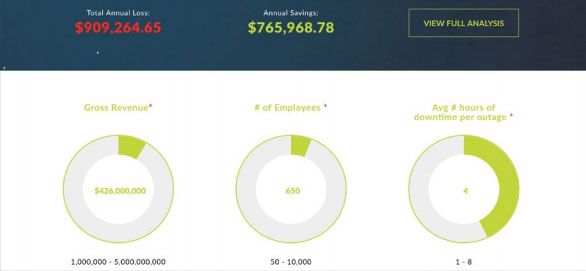Benefits of 4G Failover Solutions for Businesses
The pros and cons of leveraging 4G solutions as a backup network solution
While the majority of business owners are blissfully ignorant to the inner workings of the Cloud, they are becoming painfully aware that their business has been forever changed by it. In an age of cloud-based applications ranging from financial to marketing, from automation to production all the way through HR and payroll, if a business loses access to their applications, their operations and their profits come to a screaming halt.
Finding a balance between operational expenses and the need for their employees to have constant access to these business-critical applications is a challenge new to many business owners and forces them to make informed decisions around what is best for their company — whether they fully understand the underlying technology or not.
One of the biggest challenges many businesses will face is finding multiple internet connections available at their remote sites that offer the diversity they need at a reasonable price. Dedicated connections are expensive, whether they’re fiber or copper, and most businesses are lucky to have one cable internet available, much less two. Finding any two connections that don’t have the same last mile into the building and won’t break the bank is a difficult task.
Swooping in to make that difficult task much easier is the game-changing 4G failover solution.
Unlike wired connections, 4G will always have a diverse and wireless last mile — ensuring that an errant back-hoe won’t take it down along with your primary connection. Of course, like any solution, 4G has its challenges. Let’s look at the pros and cons of leveraging 4G in detail to determine if it could be the right solution for you.
Reliability and Coverage
One of the most persistent myths about 4G coverage is that the coverage is spotty and it isn’t reliable. The truth is that 98% of Americans now have access to 4G LTE coverage. And since most businesses are located near populous areas, the odds that your business has enough signal strength to leverage a local 4G network are pretty high.
For years, many businesses were leveraging T1 connections for their WAN failover, which only provide 1.544Mb of bandwidth. Simple speed tests done from a cell phone will show significantly better results from the 4G network, and this is a consumer grade unoptimized 4G solution. Enterprise solutions allow for antennas and signal boosters that further increase the performance of this amazing technology.
From a reliability standpoint, it’s important to keep in mind that during times of emergency the 4G network becomes a keystone in the communications solution for average citizens as well as emergency personnel. As an integral part of emergency communications, the 4G network is often the first thing to get attention in the instance of an emergency or a natural disaster. While it may not offer a 99.99% up-time on its own just yet, as a backup to a dedicated solution it’s a very suitable option.
Of course, it isn’t all unicorns and rainbows.
The 4G network does fluctuate in available bandwidth depending on how many people are using a tower. While this can be frustrating, it really isn’t any different from the challenges encountered when using a typical asymmetric broadband internet connection. Signal boosters and directional antennas go a long way in stabilizing the connection, but some changes in bandwidth are to be expected during peak hours of usage.
Costs
Many of us have had the unfortunate experience of getting an outrageous bill in the mail for our cellular service due to large data overages. So it’s easy and understandable to be a little “gun-shy” about leveraging this technology for your business.
One important thing to keep in mind when it comes to overages is that, more often than not, the applications driving large overage bills (video streaming, social media, etc.) are usually not the same ones that business consider business-critical. VoIP, credit card transactions and CRM traffic don’t use near as much bandwidth as the applications we all over-use on our phones. This means that actual business-critical traffic for a business isn’t the same as recreational traffic for the average cell phone user.
Another important point to keep in mind is that most enterprise-level solutions include software that will help to minimize overages by limiting certain types of traffic on metered connections and giving the employees access to only those applications that they need in order to continue to make the business money. This same software can also provide alerts when a site fails over to 4G, at which point tickets can be opened to get the primary connection back online (preferably by a third party managing your WAN for you). Thresholds can also be set for each site to alert a company’s IT or management team if a site is about to go over its data allotment — that way escalations can be made on the primary, and additional restrictions can be put in place on traffic if needed.
The final point to consider when it comes to evaluating how cost effective 4G is as a solution is the low static cost. When overages do occur, they can certainly make it seem like an expensive solution. However, when you take into account how little it cost as a backup on the months when there are no overages, it becomes very affordable — even when you average out the occasional spike due to overages.
For large multi-site businesses, there is also the added benefit of being able to pool data across sites. The more sites you add to the 4G backup network, the larger the pool becomes and the more time a site can spend on 4G before incurring any additional expenses.
Security and Compliance
In an era where it seems another large company gets hacked every week, security is an issue that is constantly top of mind for IT professionals. For some reason, people have a misconception that 4G is less secure than a typical internet connection, when the truth is that it’s no more or less inherently secure than a wired connection. The same security protocols that a business might take across wired internet connections are available over 4G. Many 4G routers even have the ability to automatically spin up VPN tunnels at the click of a button, making it an easy backup to private networks.
From a compliance perspective, 4G deployed correctly consistently meets PCI and HIPAA compliance standards as a primary or secondary network connection. It’s important to choose a solution provider and a hardware vendor familiar with deploying 4G solutions in an environment that will be open to the scrutiny of compliance audits. However, this is a hurdle that can be easily overcome with the right technology partner to make 4G a secure and compliant network option.
Scalability and Deployment
Another important thing to consider about 4G is the ubiquity of the solution and how quickly it can be deployed. For a company looking to expand rapidly or deploy a 4G network as a backup to their existing WAN as soon as possible, it can be as easy as putting a SIM card in a router and shipping it to a remote site.
Once plugged in (if configured correctly), the device should come online, appear in the cloud management tool (depending on the hardware provider) and be available for the IT team to configure and test. In contrast to wired telecom circuits (which can routinely take 90-120 to turn-up), the ease and speed of deployment for 4G makes it an instance game-changer.
Case Study
How Wired Networks’s 4G Solutions Worked for a Major Regional Bank
As an example of how the flexibility of 4G can make a large difference in the way your company deploys its WAN, let’s look at how Wired Networks was able to assist a regional bank looking to grow rapidly while maintaining high-availability.
Often, bank branches need to be up and running faster than carriers can bring in wired connections, leaving the branch in a “black hole” when it comes to data transfer. To solve this problem for a major regional bank in the Southeast, Wired Networks rapidly deployed a 4G router and turned it up at the new branch, creating a VPN back into the primary network and testing the full solution while onsite.
Once fully verified that the solution worked, the branch was able to conduct business over the 4G network while Wired Networks ordered and escalated the primary connection. As soon as the primary connection became available, the 4G stayed in place and simply transitioned into a backup capacity.
From the perspective of the customer, all they needed to do was provide their address and bandwidth needs for the primary circuit. We completely managed the rest for them. The site was up-and-running on time, and once the primary circuit was delivered the branch was fully redundant and highly available.
The speed and ease of this solution was fully enabled by the nature of the 4G network.
Is 4G Right For Your Company?
In conclusion, 4G won’t be the perfect solution for every company. However, it checks a lot of boxes for a lot of companies. Not only is it reliable, ubiquitous and offer a wireless last mile that will always be diverse to their primary connection, it’s also highly cost effective and flexible as a network solution.
If you’re business relies on bandwidth-heavy applications such as streaming video or large file transfers, then 4G probably isn’t going to be the saviour that you are looking for.
As for the majority of the business sector who just needs to maintain access to applications with a small bandwidth footprint (such as VoIP, ERP, CRM and finance applications), 4G is a solution that could keep your business up and running when you would otherwise have a lot of employees twiddling their thumbs.
Network Downtime Calculator
Conclusion
The Enable IP solution is like no other. Contact us to get started and experience the difference of a system that truly delivers on its 99.99% network uptime promise.Talk to an IT expert today. Contact Wired Networks to see how we can help.
Contact us
About Wired Networks
Wired Networks is a telecom solutions provider founded by Wired Networks’ founder Jeremy Kerth and head engineer Steve Roos after they realized there was a deep market need for helping mid-size businesses establish better uptime rates for their Wide Area Networks (WANs). Armed with the best-in-class carriers and partners, Jeremy and Steve set out with a bold plan: Guarantee better uptime rates than the industry standard of only 99.5%.Their bold plan became a reality. Wired Networks’s solutions guarantee clients 99.99% (even 99.999%) network uptime. But we don’t stop there. Many telecom providers promise high availability network solutions but fail to deliver because they’re in the business of providing services, not solutions.
That’s the Wired Networks difference: We deliver highly available networks by providing a complete system (called “Cloud Assurance”) that ensures 99.99% or above uptime.
We deliver this bold promise by:
- Owning the entire customer experience. From pricing, contracting, ordering and provisioning to installing, servicing and billing—we do it all! This means no stressful negotiations, confusing setups, or finger pointing if something goes wrong. We actually deliver on our promise.
- We manage the entire system, and monitor and manage issues as they occur so you can focus on your business—not your network.





